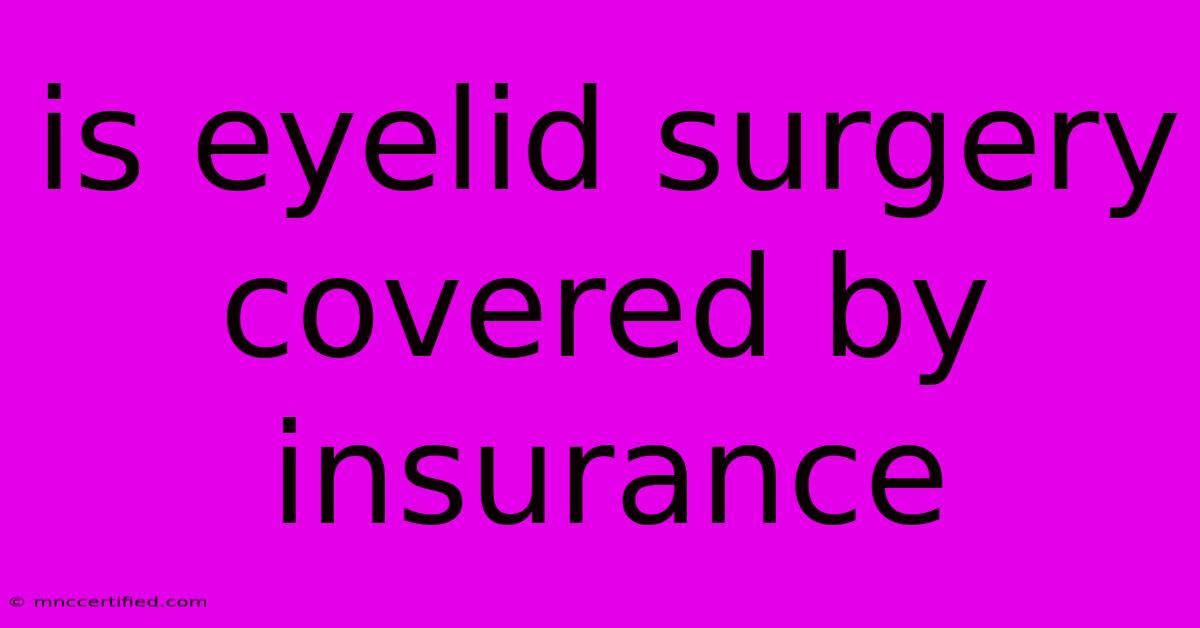Is Eyelid Surgery Covered By Insurance

Table of Contents
Is Eyelid Surgery Covered by Insurance? A Comprehensive Guide
Eyelid surgery, also known as blepharoplasty, can significantly enhance your appearance and boost your confidence. But before you schedule a consultation, it's crucial to understand whether your insurance plan will cover the procedure.
The short answer? It depends.
Insurance coverage for eyelid surgery is highly dependent on your specific plan and the reason for the procedure. While some insurance plans cover eyelid surgery for medical reasons, cosmetic procedures are typically not covered.
When is Eyelid Surgery Considered Medically Necessary?
Insurance companies generally cover eyelid surgery when it's deemed medically necessary to address specific conditions. These may include:
- Ptosis: Drooping eyelids that obstruct vision.
- Entropion: Inward turning of the eyelids, causing irritation and discomfort.
- Ectropion: Outward turning of the eyelids, leading to dryness and excessive tearing.
- Xanthelasma: Yellow, cholesterol deposits on the eyelids.
- Dermatochalasis: Excess skin on the eyelids that obstructs vision or causes irritation.
When is Eyelid Surgery Considered Cosmetic?
Eyelid surgery is considered cosmetic when performed for aesthetic reasons, such as:
- Removing excess skin and fat for a more youthful appearance.
- Reshaping the eyelids to improve symmetry.
- Reducing the appearance of fine lines and wrinkles.
In most cases, insurance companies will not cover eyelid surgery for purely cosmetic purposes.
How to Determine Coverage
- Review your insurance policy: Carefully read your policy documents or contact your insurance provider directly to understand your specific coverage for eyelid surgery.
- Consult with your doctor: Discuss your desired procedure and its potential medical necessity with your ophthalmologist or plastic surgeon. They can provide documentation to support your insurance claim.
- Obtain pre-authorization: For medically necessary procedures, your doctor will typically need to obtain pre-authorization from your insurance company before the surgery. This process ensures that the procedure is covered and helps avoid unexpected costs.
Tips for Increasing Coverage Chances
- Provide comprehensive medical documentation: Document any vision problems or physical limitations caused by your eyelid condition.
- Explore alternative treatment options: If your insurance plan requires exhausting non-surgical alternatives, ensure you document these attempts.
- Consider a combination of cosmetic and medical procedures: Some insurance plans may cover certain aspects of eyelid surgery if it's combined with a medically necessary procedure.
Cost Considerations
If your insurance doesn't cover eyelid surgery, it's important to factor in the total cost, which includes:
- Surgeon's fees: This can vary significantly based on the surgeon's experience and location.
- Anesthesia fees: General anesthesia is typically required for eyelid surgery.
- Facility fees: This covers the use of the operating room and other hospital resources.
- Post-operative care: This includes medication, follow-up appointments, and any necessary treatments.
Conclusion
Whether or not eyelid surgery is covered by insurance depends heavily on your individual plan and the medical necessity of the procedure. It's essential to thoroughly understand your policy, consult with your doctor, and explore all your options before making a decision. By understanding the factors that determine coverage, you can make an informed choice that aligns with your budget and goals. Remember, transparency with your doctor and insurance provider is key to navigating this process effectively.

Thank you for visiting our website wich cover about Is Eyelid Surgery Covered By Insurance. We hope the information provided has been useful to you. Feel free to contact us if you have any questions or need further assistance. See you next time and dont miss to bookmark.
Featured Posts
-
Rashida Jones Honoring Quincy Jones Legacy
Nov 09, 2024
-
Old Fitzgerald 10 Year Bottled In Bond
Nov 09, 2024
-
Georgina Cooper Supermodel Dies At 46
Nov 09, 2024
-
Trading In A Car With Mechanical Issues
Nov 09, 2024
-
Renewing Insurance License In Illinois
Nov 09, 2024